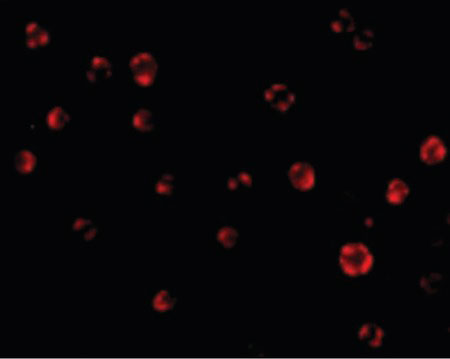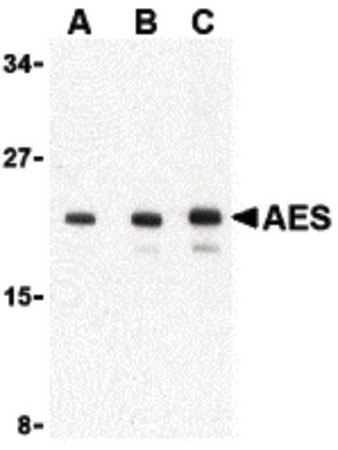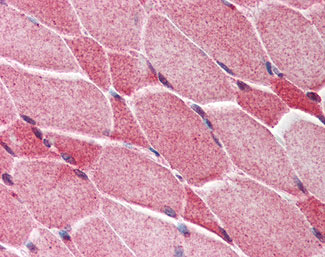AES / Groucho Antibody (C-Terminus)
Rabbit Polyclonal Antibody
- SPECIFICATION
- CITATIONS
- PROTOCOLS
- BACKGROUND

Application
| WB, IHC-P, IF, ICC |
|---|---|
| Primary Accession | Q08117 |
| Reactivity | Human, Mouse, Rat |
| Host | Rabbit |
| Clonality | Polyclonal |
| Calculated MW | 22kDa |
| Dilution | IHC-P (2.5 µg/ml), WB (1-2 µg/ml), |
| Gene ID | 166 |
|---|---|
| Other Names | Amino-terminal enhancer of split, Amino enhancer of split, Gp130-associated protein GAM, Grg-5, Groucho-related protein 5, Protein ESP1, Protein GRG, AES, GRG, GRG5 |
| Target/Specificity | 16 amino acid peptide from near the carboxy terminus of human AES |
| Reconstitution & Storage | Short term 4°C, long term aliquot and store at -20°C, avoid freeze thaw cycles. Store undiluted. |
| Precautions | AES / Groucho Antibody (C-Terminus) is for research use only and not for use in diagnostic or therapeutic procedures. |
| Name | TLE5 (HGNC:307) |
|---|---|
| Synonyms | AES, GRG, GRG5 |
| Function | Transcriptional corepressor. Acts as a dominant repressor towards other family members. Inhibits NF-kappa-B-regulated gene expression. May be required for the initiation and maintenance of the differentiated state. Essential for the transcriptional repressor activity of SIX3 during retina and lens development. |
| Cellular Location | Nucleus. |
| Tissue Location | Found predominantly in muscle, heart and Placenta. In fetal tissues, abundantly expressed in the heart, lung, kidney, brain and liver |

Thousands of laboratories across the world have published research that depended on the performance of antibodies from Abcepta to advance their research. Check out links to articles that cite our products in major peer-reviewed journals, organized by research category.
info@abcepta.com, and receive a free "I Love Antibodies" mug.
Provided below are standard protocols that you may find useful for product applications.
Background
Transcriptional corepressor. Acts as dominant repressor towards other family members. Inhibits NF-kappa-B-regulated gene expression. May be required for the initiation and maintenance of the differentiated state. Essential for the transcriptional repressor activity of SIX3 during retina and lens development.
References
Scala L.A.,et al.Submitted (DEC-1993) to the EMBL/GenBank/DDBJ databases.
Hou E.W.,et al.DNA Cell Biol. 17:911-913(1998).
Liu Y.,et al.Zhonghua Wei Sheng Wu Xue He Mian Yi Xue Za Zhi 18:106-110(1998).
Ota T.,et al.Nat. Genet. 36:40-45(2004).
Grimwood J.,et al.Nature 428:529-535(2004).
If you have used an Abcepta product and would like to share how it has performed, please click on the "Submit Review" button and provide the requested information. Our staff will examine and post your review and contact you if needed.
If you have any additional inquiries please email technical services at tech@abcepta.com.













 Foundational characteristics of cancer include proliferation, angiogenesis, migration, evasion of apoptosis, and cellular immortality. Find key markers for these cellular processes and antibodies to detect them.
Foundational characteristics of cancer include proliferation, angiogenesis, migration, evasion of apoptosis, and cellular immortality. Find key markers for these cellular processes and antibodies to detect them. The SUMOplot™ Analysis Program predicts and scores sumoylation sites in your protein. SUMOylation is a post-translational modification involved in various cellular processes, such as nuclear-cytosolic transport, transcriptional regulation, apoptosis, protein stability, response to stress, and progression through the cell cycle.
The SUMOplot™ Analysis Program predicts and scores sumoylation sites in your protein. SUMOylation is a post-translational modification involved in various cellular processes, such as nuclear-cytosolic transport, transcriptional regulation, apoptosis, protein stability, response to stress, and progression through the cell cycle. The Autophagy Receptor Motif Plotter predicts and scores autophagy receptor binding sites in your protein. Identifying proteins connected to this pathway is critical to understanding the role of autophagy in physiological as well as pathological processes such as development, differentiation, neurodegenerative diseases, stress, infection, and cancer.
The Autophagy Receptor Motif Plotter predicts and scores autophagy receptor binding sites in your protein. Identifying proteins connected to this pathway is critical to understanding the role of autophagy in physiological as well as pathological processes such as development, differentiation, neurodegenerative diseases, stress, infection, and cancer.





